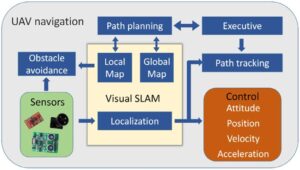Introduction
Drone-based delivery services involve the use of unmanned aerial vehicles (UAVs) or drones to transport goods and packages from one location to another. This innovative delivery method offers several advantages over traditional ground-based transportation, including faster delivery times, reduced costs, and increased accessibility to remote or hard-to-reach areas. Here’s an overview of drone-based delivery services:
How Drone Delivery Works:
- Order Placement:
- Customers place orders through an online platform or mobile app, specifying the delivery address and package details.
- Package Preparation:
- The package is prepared for delivery and equipped with a tracking device or barcode for monitoring and identification purposes.
- Drone Deployment:
- A drone is dispatched from a designated launch site or distribution center, equipped with the package and navigation systems.
- Flight Navigation:

- The drone navigates its flight path using GPS technology and onboard sensors to ensure safe and efficient navigation, avoiding obstacles and adhering to airspace regulations.
- Delivery Confirmation:
- Upon reaching the destination, the drone safely lands or hovers above the designated delivery area. The package is then released or lowered to the ground, and delivery confirmation is sent to the recipient.
Key Benefits of Drone Delivery Services:
- Faster Delivery Times:
- Drones can bypass traffic congestion and deliver packages directly to the recipient’s location, resulting in significantly faster delivery times compared to ground-based transportation methods.
- Cost-Effective:
- Drone delivery services can be more cost-effective than traditional delivery methods, especially for remote or rural areas where infrastructure may be limited or expensive to maintain.
- Increased Accessibility:
- Drones can reach remote or hard-to-access areas, including rural communities, islands, and disaster zones, providing residents with access to essential goods and services.
- Environmental Sustainability:
- Drone delivery services have the potential to reduce carbon emissions and environmental impact compared to traditional delivery vehicles, especially for short-distance deliveries.
- Enhanced Safety and Security:
- Drones can operate in hazardous or challenging environments, reducing the risk to human delivery personnel and ensuring the safe and secure transportation of goods.
- Innovative Solutions:
- Drone technology enables innovative delivery solutions, such as airborne delivery hubs, autonomous delivery routes, and real-time package tracking, enhancing the overall customer experience.
Applications of Drone Delivery Services:
- E-commerce and Retail: Delivering online orders, groceries, and consumer goods directly to customers’ doorsteps.
- Healthcare and Medical Supplies: Transporting medical supplies, vaccines, and emergency supplies to remote or disaster-stricken areas.
- Logistics and Supply Chain: Streamlining logistics operations, inventory management, and last-mile delivery for businesses and warehouses.
- Emergency Response and Disaster Relief: Providing rapid response and delivery of essential supplies during emergencies, natural disasters, and humanitarian crises.
Pros of drone-based delivery services:
- Speed and Efficiency: Drones can bypass traffic and other obstacles, allowing for faster delivery times, especially in urban areas where congestion is common.
- Cost-Effective: Drone delivery can be more cost-effective compared to traditional delivery methods, especially for short-distance deliveries.
- Accessibility: Drones can reach remote or hard-to-access areas, providing access to goods and services for communities that may be otherwise underserved.
- Environmental Sustainability: Drones produce fewer carbon emissions compared to traditional delivery vehicles, contributing to environmental sustainability.
- Innovation: Drone delivery services represent innovative solutions that can enhance logistics operations and improve last-mile delivery efficiency.
Cons of drone-based delivery services
- Regulatory Challenges: Regulatory restrictions and airspace regulations can limit the use of drones for delivery services, particularly in densely populated areas or near airports.
- Limited Payload Capacity: Most drones have limited payload capacity, which restricts the size and weight of packages that can be delivered.
- Weather Conditions: Adverse weather conditions such as strong winds, rain, or snow can impact the safety and reliability of drone operations.
- Security Concerns: Drones may be vulnerable to hacking or interference, posing security risks for the delivery of sensitive or valuable goods.
- Noise Pollution: The buzzing sound of drones can cause noise pollution, especially in residential areas, affecting quality of life for residents.
- Safety Risks: Inexperienced or reckless drone operators can pose safety risks to pedestrians, vehicles, and property, leading to accidents or collisions.
- Limited Range: Drones have limited range and battery life, which may restrict their ability to cover long distances or operate continuously for extended periods.
- Technological Limitations: Current drone technology may not be fully matured, with limitations in navigation, communication, and autonomous capabilities.
Conclusion
In conclusion, drone-based delivery services represent a transformative innovation with the potential to revolutionize logistics and transportation systems worldwide. Despite facing regulatory challenges, technological limitations, and safety concerns, the advantages of drone delivery services are undeniable. It holds the promise of reducing costs, minimizing environmental impact, and improving last-mile delivery efficiency. Moreover, drone technology continues to evolve rapidly, with ongoing advancements in navigation, communication, and autonomous capabilities. While challenges such as regulatory compliance, security risks, and weather conditions must be addressed, the benefits of drone-based delivery services outweigh the drawbacks. As regulatory frameworks adapt and technology matures, drone delivery services have the potential to enhance global supply chains, support disaster relief efforts, and improve access to essential goods and services for communities worldwide.

